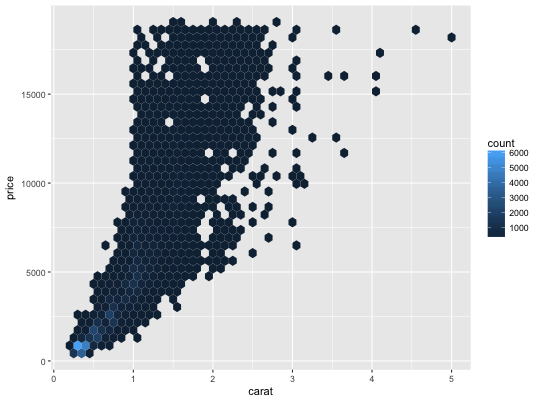Hexagonal heatmap of 2d bin counts
Divides the plane into regular hexagons, counts the number of cases in
each hexagon, and then (by default) maps the number of cases to the hexagon
fill. Hexagon bins avoid the visual artefacts sometimes generated by
the very regular alignment of geom_bin2d.
geom_hex(mapping = NULL, data = NULL, stat = "binhex", position = "identity", ..., na.rm = FALSE, show.legend = NA, inherit.aes = TRUE) stat_bin_hex(mapping = NULL, data = NULL, geom = "hex", position = "identity", ..., bins = 30, binwidth = NULL, na.rm = FALSE, show.legend = NA, inherit.aes = TRUE)
Arguments
| mapping | Set of aesthetic mappings created by |
|---|---|
| data | The data to be displayed in this layer. There are three options: If A A |
| position | Position adjustment, either as a string, or the result of a call to a position adjustment function. |
| ... | other arguments passed on to |
| na.rm | If |
| show.legend | logical. Should this layer be included in the legends?
|
| inherit.aes | If |
| geom, stat | Override the default connection between |
| bins | numeric vector giving number of bins in both vertical and horizontal directions. Set to 30 by default. |
| binwidth | Numeric vector giving bin width in both vertical and
horizontal directions. Overrides |
Aesthetics
geom_hex understands the following aesthetics (required aesthetics are in bold):
xyalphacolourfillgroupsize
See also
stat_bin2d for rectangular binning
Examples
# You can control the size of the bins by specifying the number of # bins in each direction: d + geom_hex(bins = 10)d + geom_hex(bins = 30)# Or by specifying the width of the bins d + geom_hex(binwidth = c(1, 1000))d + geom_hex(binwidth = c(.1, 500))




